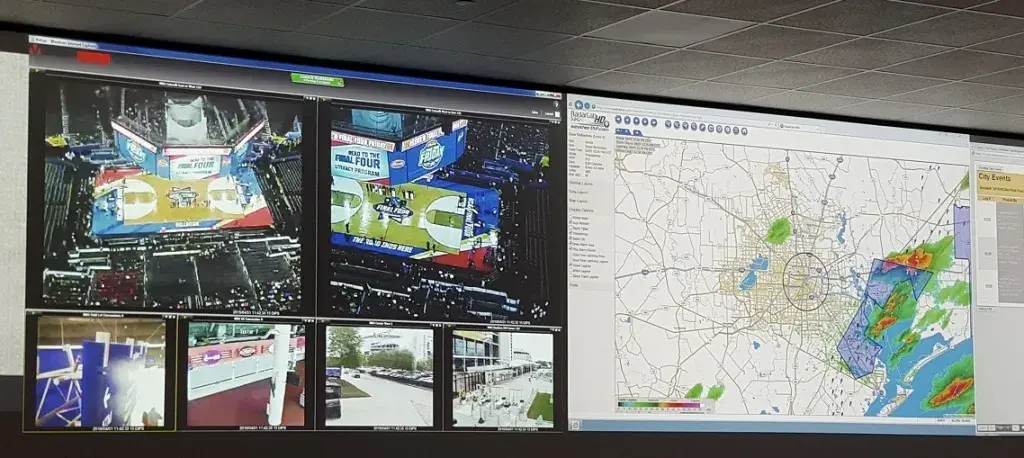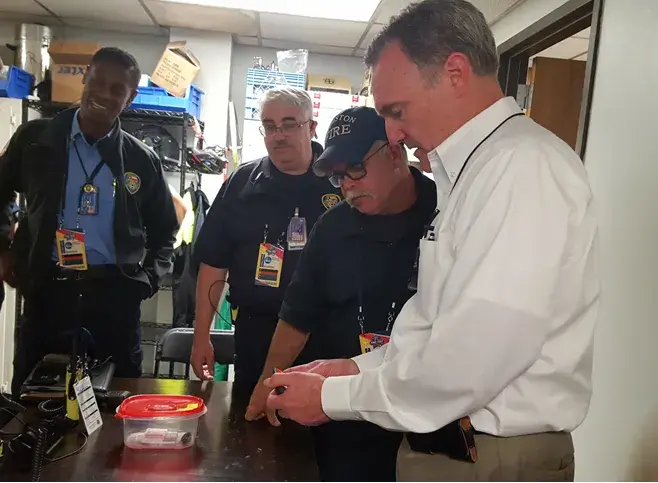The Department of Homeland Security (DHS) Science and Technology Directorate’s (S&T) game changing datacasting system was successfully used by the City of Houston and its first responders to securely share information between different responding agencies during the Republican Presidential Candidates’ Debate on February 25 and the NCAA Men’s Final Four Basketball Tournament April 1-4.
 During the debate, both the University of Houston (UH) Office of Emergency Management (OEM) and the City of Houston OEM leveraged the datacasting network to share each other’s emergency operations center (EOC) displays. Each location had camera views that could benefit the other, making this exchange a huge asset. Both centers and mobile command posts also received live video feeds from the Houston Police Department (HPD) helicopters. Helicopter cameras showed areas where crowds converged, allowing officers to dispatch to the scene and ensure everyone’s safety. Prior to datacasting, the City of Houston was unable to bridge communication, share information and connect numerous security cameras around the building and surrounding areas, such as main arteries of nearby streets and freeways. Datacasting enabled first responders on the scene to provide seamless security at its first large public event.
During the debate, both the University of Houston (UH) Office of Emergency Management (OEM) and the City of Houston OEM leveraged the datacasting network to share each other’s emergency operations center (EOC) displays. Each location had camera views that could benefit the other, making this exchange a huge asset. Both centers and mobile command posts also received live video feeds from the Houston Police Department (HPD) helicopters. Helicopter cameras showed areas where crowds converged, allowing officers to dispatch to the scene and ensure everyone’s safety. Prior to datacasting, the City of Houston was unable to bridge communication, share information and connect numerous security cameras around the building and surrounding areas, such as main arteries of nearby streets and freeways. Datacasting enabled first responders on the scene to provide seamless security at its first large public event.
In addition to the Final Four games, this technology was also used during related events held throughout the weekend. This included the accompanying Fan Fest, a four-day, free festival with numerous concerts and events. These events were incredibly packed, nearing capacity with attendee totals nearing 75,000 daily. There were limited cameras and some areas did not have any coverage at all. All of these factors can be a high concern for security officials. Footage from various surveillance cameras and mobile devices live streaming via the datacasting system.
Due to the positive impact of the datacasting system and the support provided by S&T, Johns Hopkins University Applied Physics Lab and subcontractor SpectraRep, the director of Houston’s Office of Public Safety and Homeland Security, Dennis Storemski personally thanked the team for their support. He noted, “It took a great deal of time and planning to have the event run as it did. The technical support, guidance and active participation of your department assisted in the implementation of this new strategy. Your efforts during the Final Four were extremely valuable to us and your expertise will assist us in improving our use of this communications system. Thank you again for your participation, input and continued service in support of the first responder community.”
Throughout the weekend, the datacasting system allowed public safety officials to securely send and stream encrypted video, text messages and other files using a dedicated portion of the digital broadcast television spectrum to specific recipients. Officials were able to view live streaming footage from various security cameras stationed throughout the stadium and surrounding areas via the datacasting system on their tablets and computers from their command posts. Additionally, officers in the field were able to capture and upload live footage from their post locations to share with nearby officers and the EOC. This greatly increased situational awareness and the ability to monitor and mitigate any potential safety issues. Houston Firefighters installing the datacasting app to their phones to collect footage from the field.
 Rick Flanagan, Houston’s Emergency Manager commented on the ease of using datacasting from a phone, “All you have to do is download the app and push a button, and you can have an integral part in capturing information.”
Rick Flanagan, Houston’s Emergency Manager commented on the ease of using datacasting from a phone, “All you have to do is download the app and push a button, and you can have an integral part in capturing information.”
The HPD, Houston Fire Department, Harris County Sheriff's Office, Joint Hazards Assessment Team and public safety partners from UH, the George R. Brown Convention Center and NRG Stadium all participated in these events, resulting in numerous new users. A report will be drafted and posted to FirstReponder.gov on the lessons learned, potential improvements, additional capabilities and information exchanges with end users.
These events further demonstrated the potential datacasting has in becoming an important component in the nation’s public safety telecommunications architecture, with interest in this technology continuously growing. Houston will continue to use this tool in its day-to-day operations and potentially during the Super Bowl next year. S&T and the City of Houston will continue this partnership and look forward to future collaborations on this and other public safety efforts.
